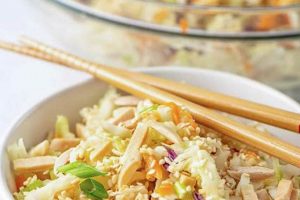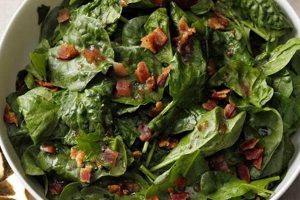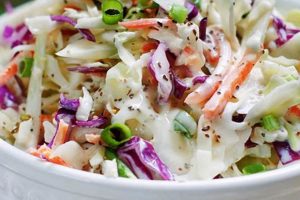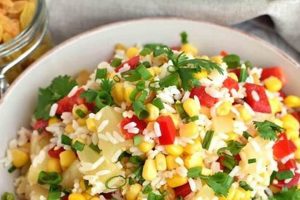Uncooked cauliflower, finely chopped or riced, forms the base of these dishes, offering a versatile canvas for diverse flavor combinations. These salads often incorporate a variety of fresh ingredients, such as other vegetables, fruits, herbs, nuts, and seeds, bound together with a flavorful dressing. An example could include riced cauliflower combined with chopped carrots, red onion, cilantro, and toasted almonds, tossed in a lemon-tahini dressing.
This preparation method preserves the vegetable’s crisp texture and nutrient density, providing a good source of vitamins, minerals, and fiber. Avoiding cooking also simplifies preparation, making such salads a convenient and healthy meal option. While the concept of consuming uncooked vegetables is ancient, the rise in popularity of salads centered around raw cauliflower is a more recent trend, reflecting increasing interest in plant-forward diets and convenient, healthy eating.
The following sections will explore various aspects of preparing these salads, including different techniques for processing cauliflower, diverse ingredient pairings, and a range of dressing options. Nutritional information and potential health benefits will also be discussed.
Tips for Raw Cauliflower Salad Recipes
Maximizing flavor and texture requires attention to detail throughout the preparation process. The following tips offer guidance for creating delicious and satisfying raw cauliflower salads.
Tip 1: Proper Cauliflower Preparation: Pulse cauliflower florets in a food processor until they resemble rice-sized pieces. Avoid over-processing, which can result in a mushy texture. Alternatively, grate cauliflower using a box grater for a coarser texture.
Tip 2: Enhancing Flavor through Marinades: A brief marinade can infuse cauliflower rice with additional flavor. Consider using a mixture of olive oil, lemon juice, and herbs. Marinating for 15-30 minutes before combining with other ingredients is typically sufficient.
Tip 3: Balancing Textures: Combine cauliflower rice with ingredients offering contrasting textures. Nuts, seeds, and dried fruits add crunch, while softer elements like avocado or chopped fresh herbs contribute creaminess and varied mouthfeel.
Tip 4: Dressing Selection: The dressing plays a crucial role in the overall flavor profile. Vinaigrettes, creamy dressings, and tahini-based sauces complement raw cauliflower well. Adjust dressing amounts to personal preference.
Tip 5: Ingredient Incorporation: Add ingredients gradually, tasting and adjusting seasonings as needed. This ensures a balanced and well-integrated flavor profile.
Tip 6: Storage Considerations: While best consumed fresh, these salads can be stored in airtight containers in the refrigerator for up to two days. Note that some ingredients, such as avocado, may oxidize and change color over time.
Tip 7: Creative Flavor Combinations: Explore diverse cuisines for inspiration. Mediterranean, Asian, and Mexican flavors all pair well with raw cauliflower. Experiment with different herbs, spices, and dressings to discover preferred flavor profiles.
By following these tips, one can consistently create flavorful and satisfying raw cauliflower salads that offer both nutritional value and culinary enjoyment.
These guidelines provide a foundation for successful raw cauliflower salad preparation. The following section will delve into specific recipe examples showcasing diverse ingredient combinations and flavor profiles.
1. Riced Cauliflower
Riced cauliflower serves as the foundation for raw cauliflower salads, offering a neutral base that readily absorbs flavors from other ingredients. Its texture, reminiscent of cooked rice, provides a satisfying mouthfeel while contributing minimal calories. This characteristic makes it a popular substitute for grains in various dishes, including salads. The process of ricing cauliflower involves breaking down the florets into small, grain-like pieces, typically achieved through pulsing in a food processor or grating. This creates a versatile ingredient suitable for raw consumption, providing a blank canvas for diverse flavor profiles.
The importance of riced cauliflower in these salads extends beyond its textural contribution. It offers nutritional benefits, providing a good source of vitamins, minerals, and fiber. Furthermore, its neutral flavor allows it to harmonize with a wide array of ingredients, from fresh vegetables and herbs to nuts, seeds, and dried fruits. For example, a Mediterranean-inspired salad might combine riced cauliflower with chopped cucumbers, tomatoes, Kalamata olives, and feta cheese, dressed with a lemon-herb vinaigrette. Alternatively, an Asian-inspired version could incorporate ingredients like shredded carrots, red cabbage, edamame, and a sesame-ginger dressing. The versatility of riced cauliflower allows for endless culinary creativity.
Understanding the role of riced cauliflower is essential for successful raw cauliflower salad preparation. It offers a healthy, low-calorie base that can be customized to suit various tastes and dietary preferences. The ease of preparation, combined with its nutritional value and culinary versatility, establishes riced cauliflower as a key component in these salads. Mastering this core ingredient empowers culinary exploration and promotes healthy eating habits.
2. Fresh Ingredients
Fresh ingredients are essential for maximizing the flavor, texture, and nutritional value of raw cauliflower salad recipes. The inherent neutrality of raw cauliflower provides a canvas for the vibrant flavors of fresh produce, herbs, and other complementary components. This synergy creates a dynamic sensory experience, elevating the salad beyond a simple combination of ingredients. The crispness of raw vegetables, the brightness of fresh herbs, and the subtle sweetness of fruits contribute layers of complexity to the dish. For instance, a salad featuring raw cauliflower, chopped bell peppers, red onion, cilantro, and a lime-cilantro dressing exemplifies the integral role of fresh ingredients in creating a vibrant and flavorful experience. The absence of cooking preserves the integrity of these ingredients, allowing their natural flavors and textures to shine through.
The emphasis on fresh ingredients also aligns with the nutritional goals often associated with raw cauliflower salads. These salads are frequently chosen for their health benefits, and incorporating fresh, unprocessed ingredients amplifies the nutritional density. Vitamins, minerals, and antioxidants are preserved, contributing to a dish that is both flavorful and nutrient-rich. Furthermore, the use of fresh ingredients offers opportunities for creative customization. Seasonal variations allow for ongoing exploration of flavor profiles, ensuring a dynamic and engaging culinary experience throughout the year. Adapting recipes to incorporate locally sourced, in-season produce maximizes freshness and minimizes environmental impact.
Integrating fresh, high-quality ingredients is paramount to crafting successful raw cauliflower salads. This approach not only enhances flavor and texture but also maximizes nutritional value. The versatility of raw cauliflower allows for seamless integration of diverse ingredients, offering a platform for culinary creativity and customization. Prioritizing fresh ingredients ensures a vibrant, healthful, and satisfying culinary experience.
3. Flavorful Dressings
Flavorful dressings are essential for transforming raw cauliflower rice from a relatively bland base into a vibrant and palatable salad. The right dressing provides the crucial bridge, connecting the individual components and unifying the overall flavor profile. Because raw cauliflower possesses a mild, slightly sweet taste, it readily absorbs the flavors of the dressing, making the dressing a primary flavor driver in the dish. The interplay between the dressing and other ingredients creates a balanced and harmonious culinary experience. A creamy avocado-lime dressing, for example, can complement the subtle sweetness of cauliflower while adding richness and acidity. Conversely, a light vinaigrette with Dijon mustard and herbs can offer a brighter, more tangy counterpoint. The careful selection of a dressing dictates the overall character of the salad.
The choice of dressing also impacts the textural dimension of the salad. Creamy dressings, such as those based on tahini, yogurt, or avocado, can coat the cauliflower rice, adding a luscious mouthfeel. Vinaigrettes, on the other hand, offer a lighter touch, preserving the crispness of the raw vegetables. Furthermore, the dressing contributes to the overall nutritional profile. Dressings incorporating healthy fats, like those from olive oil or avocado, enhance the bioavailability of fat-soluble vitamins present in the other salad ingredients. A well-chosen dressing can also introduce additional flavors and nutrients through the inclusion of herbs, spices, or citrus juices. For instance, a lemon-tahini dressing provides healthy fats, antioxidants, and a vibrant citrusy note.
Mastering the art of dressing selection is crucial for creating successful raw cauliflower salads. The dressing not only dictates the primary flavor profile but also influences texture and nutritional value. Consideration of these factors allows for informed choices, aligning the dressing with the desired culinary outcome. Understanding this interplay empowers culinary creativity and elevates raw cauliflower salads from simple to sophisticated dishes.
4. Varied Textures
Textural diversity significantly impacts the enjoyment and satisfaction derived from raw cauliflower salad recipes. The inherent texture of raw cauliflower, while pleasant, benefits from the incorporation of contrasting elements. This interplay of textures creates a more dynamic and engaging sensory experience. Consider the contrast between the slight crunch of finely chopped raw cauliflower and the satisfying chewiness of dried cranberries or the crisp snap of toasted slivered almonds. These textural variations prevent monotony, stimulating the palate and enhancing overall enjoyment. A salad consisting solely of riced cauliflower, even with a flavorful dressing, can lack the textural complexity that elevates a dish from simple to sophisticated.
Achieving textural variety relies on strategic ingredient selection and preparation methods. Nuts and seeds offer readily available sources of crunch. Toasting them further intensifies their inherent crispness and enhances their flavor profile. Dried fruits, such as cranberries, raisins, or apricots, contribute a chewy texture, contrasting with the cruciferous vegetable’s firmness. Fresh herbs, like parsley or cilantro, introduce a softer element, while vegetables like chopped bell peppers or shredded carrots offer varying degrees of crispness. Even the choice of dressing can influence texture, with creamy dressings adding a smooth, velvety counterpoint to the other ingredients. For instance, a salad combining riced cauliflower, toasted sunflower seeds, chopped cucumber, crumbled feta cheese, and a lemon-herb vinaigrette demonstrates the dynamic interplay of textures achievable through thoughtful ingredient selection.
Understanding the importance of textural variation is crucial for optimizing raw cauliflower salad recipes. It elevates these dishes beyond basic sustenance, transforming them into multi-dimensional culinary experiences. Thoughtful consideration of texture, alongside flavor and nutritional value, ensures a more satisfying and enjoyable meal. This principle extends beyond mere enjoyment; it can also influence satiety. A texturally diverse salad can be more filling and satisfying, contributing to better portion control and promoting healthier eating habits. Therefore, prioritizing textural variation is essential for crafting truly successful and satisfying raw cauliflower salads.
5. Nutritional Value
Nutritional value represents a cornerstone of raw cauliflower salad recipes, directly influencing their appeal within health-conscious dietary practices. Raw cauliflower itself offers a rich nutritional profile, providing a significant source of vitamins, minerals, and fiber. Crucially, the absence of cooking preserves these nutrients, maximizing their bioavailability. Vitamin C, vital for immune function and antioxidant protection, remains intact, unlike in cooked preparations where heat can degrade this essential nutrient. Similarly, the fiber content, crucial for digestive health and satiety, remains fully preserved in raw form, contributing to the salad’s overall health benefits. This nutritional foundation establishes raw cauliflower salads as more than just palatable meals; they become active contributors to well-being. For example, a salad combining raw cauliflower with other nutrient-dense vegetables like broccoli and bell peppers further amplifies the vitamin and mineral content, creating a potent dietary powerhouse.
Beyond the inherent nutritional benefits of raw cauliflower, the inclusion of other fresh ingredients further enhances the nutritional profile. Adding ingredients like leafy greens, nuts, seeds, and fruits creates a synergistic blend of vitamins, minerals, antioxidants, and healthy fats. These additions not only diversify the flavor and texture but also amplify the salad’s nutritional impact. The choice of dressing also plays a role. Opting for dressings based on olive oil, avocado, or tahini introduces healthy fats, enhancing the absorption of fat-soluble vitamins and contributing to overall nutrient density. For instance, a dressing featuring avocado oil and lemon juice not only complements the flavor of the salad but also delivers healthy monounsaturated fats and vitamin C. This careful consideration of ingredient pairings and dressing choices allows for the creation of nutritionally balanced and complete meals.
Maximizing nutritional value in raw cauliflower salad recipes requires a holistic approach. Prioritizing fresh, unprocessed ingredients, choosing nutrient-rich additions, and utilizing dressings that complement and enhance the nutritional profile are essential considerations. This awareness transforms raw cauliflower salads from simple meals into potent tools for supporting health and well-being. Understanding the nutritional implications of ingredient choices empowers informed decision-making, enabling individuals to tailor their salads to meet specific dietary needs and optimize nutritional intake.
6. Versatile Combinations
The versatility of raw cauliflower as a base ingredient significantly expands the potential for diverse flavor combinations within salad recipes. Cauliflower’s neutral flavor profile allows it to seamlessly integrate with a wide array of ingredients, spanning various culinary traditions and dietary preferences. This adaptability fosters culinary creativity, enabling the creation of salads that cater to individual tastes and nutritional goals. Cause and effect relationships emerge: the neutral base of cauliflower allows for pronounced flavor influences from added ingredients, whether a bright, citrusy profile or a savory, umami-rich experience. For instance, a Mediterranean-inspired salad might incorporate ingredients like Kalamata olives, feta cheese, and a lemon-herb vinaigrette, while a Thai-inspired version could feature peanuts, cilantro, and a lime-ginger dressing. The inherent versatility of raw cauliflower facilitates these diverse flavor profiles.
The importance of versatile combinations extends beyond mere flavor exploration. It enables the creation of nutritionally balanced meals by incorporating a variety of vegetables, fruits, proteins, and healthy fats. This adaptability is practically significant for individuals seeking to adhere to specific dietary restrictions or preferences. A vegan salad might utilize chickpeas and toasted sunflower seeds for protein and healthy fats, while a paleo-friendly version could incorporate grilled chicken or fish and avocado. Furthermore, the versatility of raw cauliflower salads allows for seasonal adaptations. Utilizing readily available, in-season produce maximizes freshness and nutritional value while minimizing environmental impact. Spring salads might feature asparagus and fresh peas, while autumnal versions could incorporate roasted butternut squash and dried cranberries. This adaptability ensures year-round enjoyment and aligns with sustainable culinary practices.
In summary, the versatility inherent in raw cauliflower salad recipes represents a significant advantage, promoting culinary exploration, nutritional balance, and dietary flexibility. This characteristic allows for creative flavor combinations, customized ingredient pairings, and seasonal adaptations, ensuring both enjoyment and nutritional optimization. Understanding this versatility empowers informed recipe development and promotes a more diverse and healthful approach to salad preparation. It also addresses the challenge of dietary monotony, offering a flexible framework for incorporating a wide range of flavors and nutrients within a single dish. This versatility positions raw cauliflower salads as a valuable component of a balanced and adaptable dietary repertoire.
7. Easy Preparation
Ease of preparation significantly contributes to the appeal of raw cauliflower salad recipes, positioning them as convenient and accessible meal options. This characteristic aligns with contemporary lifestyle demands, where time constraints often influence dietary choices. The inherent simplicity of these recipes removes a significant barrier to healthy eating, making them practical for individuals with busy schedules or limited culinary experience. Understanding the components contributing to this ease of preparation further clarifies the connection between convenience and healthful eating habits.
- Minimal Processing:
Raw cauliflower salads require minimal processing of the core ingredient. Transforming cauliflower into rice involves a simple pulsing in a food processor or grating by hand. This eliminates the need for cooking, reducing preparation time significantly and preserving the vegetable’s natural nutrients. Compared to more complex salad preparations requiring multiple cooking steps and ingredient manipulations, the relative simplicity of raw cauliflower salads underscores their convenience.
- Quick Assembly:
Once the cauliflower is riced, assembling the salad typically involves combining pre-chopped vegetables, fruits, herbs, and other desired ingredients. This straightforward process requires minimal active cooking time, allowing for rapid meal preparation. A basic raw cauliflower salad can be assembled in minutes, offering a practical solution for quick lunches or weeknight dinners. This speed and simplicity contrast sharply with more elaborate salad preparations that demand significant time investments.
- Adaptable Ingredients:
The versatility of raw cauliflower salads extends to ingredient selection. These recipes readily accommodate a wide range of readily available ingredients, from pre-chopped vegetables and bagged salad mixes to canned beans and pre-cooked proteins. Utilizing these convenient ingredients further streamlines the preparation process, minimizing the need for extensive chopping, slicing, or cooking. This adaptability simplifies meal planning and reduces overall preparation time.
- Make-Ahead Convenience:
Many raw cauliflower salad recipes lend themselves well to advance preparation. The riced cauliflower base and many accompanying ingredients can be prepared and stored separately, then combined shortly before serving. This make-ahead convenience further simplifies meal management, allowing for efficient utilization of time and reducing the pressure of last-minute meal preparation. This characteristic proves particularly beneficial for meal prepping or packing lunches, further enhancing the practicality of raw cauliflower salads.
The convergence of these factorsminimal processing, quick assembly, adaptable ingredients, and make-ahead convenienceestablishes easy preparation as a defining characteristic of raw cauliflower salad recipes. This inherent simplicity promotes accessibility, making healthy eating a more achievable and sustainable practice. By removing the obstacle of extensive preparation, these recipes encourage healthier dietary choices, contributing to improved overall well-being and simplifying meal management within the context of demanding lifestyles.
Frequently Asked Questions
This section addresses common inquiries regarding raw cauliflower salad recipes, providing clear and concise information to facilitate successful preparation and enjoyment.
Question 1: How is raw cauliflower best prepared for salads?
Ricing cauliflower using a food processor or grating it by hand yields optimal results. Over-processing should be avoided to maintain desirable texture. Alternative methods, such as finely chopping, can also be employed, depending on the desired salad consistency.
Question 2: Can raw cauliflower be consumed safely?
Thorough washing removes potential contaminants, rendering raw cauliflower safe for consumption. Individuals with specific digestive sensitivities might experience mild discomfort, but generally, raw cauliflower poses minimal risk.
Question 3: How long can raw cauliflower salad be stored?
Refrigeration in airtight containers preserves freshness for up to two days. Oxidation may affect certain ingredients, such as avocado, altering their appearance over time, but not necessarily compromising safety.
Question 4: What dressings best complement raw cauliflower salads?
Versatile options include vinaigrettes, creamy dressings (e.g., tahini or avocado-based), and yogurt-based sauces. Flavor profiles should be selected to complement other salad ingredients.
Question 5: How can nutritional value be maximized in these salads?
Incorporating a variety of fresh, nutrient-dense vegetables, fruits, nuts, seeds, and lean proteins enhances nutritional value. Dressings prepared with healthy fats, such as olive oil or avocado oil, contribute additional nutritional benefits.
Question 6: Are there specific flavor combinations recommended for raw cauliflower salads?
Numerous flavor profiles successfully complement raw cauliflower. Mediterranean, Asian, and Mexican-inspired combinations are popular choices. Experimentation with herbs, spices, and dressings is encouraged to discover preferred flavor profiles.
Addressing these common questions provides a solid foundation for understanding and utilizing raw cauliflower in salad preparations. Careful consideration of these points ensures both enjoyable and healthful culinary experiences.
The following section will provide specific recipe examples illustrating the principles discussed.
Conclusion
Exploration of the topic has revealed the versatility and adaptability inherent in formulations centered around uncooked cauliflower. From the foundational role of properly prepared cauliflower rice to the strategic integration of fresh ingredients, flavorful dressings, and varied textures, the potential for culinary creativity is evident. Nutritional value remains a significant driver of interest in these salads, with the preservation of vitamins, minerals, and fiber through raw preparation highlighted as a key benefit. The ease of preparation further enhances the appeal, offering convenient and healthful meal options suitable for diverse lifestyles and dietary preferences. Examination of various flavor combinations, from Mediterranean to Asian-inspired profiles, underscores the adaptability of this core ingredient. Addressing frequently asked questions regarding preparation, storage, and ingredient selection provides practical guidance for successful implementation.
Culinary innovation continues to expand the possibilities of raw cauliflower as a foundation for healthful and flavorful dishes. Further exploration of global culinary traditions promises to unlock new flavor profiles and ingredient pairings, ensuring the ongoing evolution and sustained relevance of raw cauliflower within the culinary landscape. The adaptability of these recipes positions them not as static entities but as dynamic platforms for ongoing culinary exploration and personalized dietary expression.






